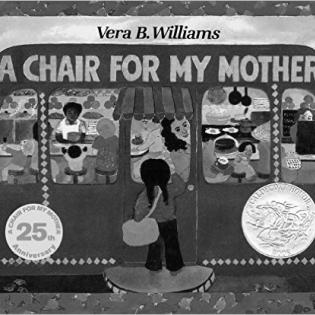A Chair For My Mother Literature Guide
Is your child a saver or a spender? Teaching our children to make choices with money is important because in too few years they need to manage their own money to support themselves. Share the story of A Chair for My Mother to teach your children about the joy and excitement of saving for a special purchase. The characters in the story lose their home and furniture in a fire. In a wonderful community effort, they are given many of the things they need for their new apartment, but not a comfortable chair. Through scrimping and saving, the family saves money in a jar until they can buy the chair of their dreams where they snuggle in the end, proud of their combined effort. Frugality can be taught, and perhaps we all can do a better job helping our children learn about saving money and making wise choices. This story is not only about saving money, but also about the ways families and the communities support each other and work together for a common goal.
Before Reading
ASK: What would you do with $10 if I gave it to you right now? Listen without judgment and without trying to influence the choices. You may need to help younger children understand what you can buy with $10 (food, toys, books) or what larger purchase the money could go toward.
SHOW: Look at the pictures on the very last page of the book. What can you tell about this family from these pictures?
CONNECT: There are three things you can do with money that you earn: spend it, save it, or donate it. Read to find out what the family in this story does with their money.
During Reading
ASK: How did family and neighbors help when the girl’s family found their home burned down? How did they feel about the help?
SHOW: The chair that they dreamed about. How do you think they felt when they found it? Notice how the artist made the chair stand out in the picture?
CONNECT: Have you ever helped or been helped by extended family or a neighbor? What happened and how did it make you feel?
After Reading
ASK: Why was the chair important to them? What did the family do with their money: save it, spend it, or donate it? What do you think they will do with their money next?
SHOW: Look at pictures throughout the book. Find examples of the girl’s family loving and supporting her.
CONNECT: Is there something that your family would like to have (something for the house, a trip, some time together) but it costs too much money? Are you willing to add your own money to get it?
Activities
- Discuss ideas for saving. Set a personal goal by discussing costs and how long it will take to save for desired items.
- Talk about why people choose to donate money. Discuss what nonprofit groups you support financially. Talk about why those issues are important to you. Recall from the story how people shared with the family who lost everything. Together choose a charity related to your interests.
- Make a homemade bank with three parts. Use the bank to sort earned money into three categories: money to spend on immediate wants, money to save for a special purchase, and money to donate.
- Use a variety of recycled containers for the three-part bank such as water bottles, milk containers, cardboard tubes, or potato chip tubes. Glue or tape the three cylinder-shaped containers side by side so the openings all face the same way.
- Decorate the container with a variety of collage and art materials (buttons, glitter, cut up fabric, pieces of felt, markers, glue, etc.)
- Label the sections of the bank with spend, save and donate.
- Adults - consider matching funds for saving and donating to discourage immediate spending.
- Contact a local community center to find out if anyone in the community has a furniture need such as a crib. Set a financial goal and get a large jar for everyone in the family to start saving toward the purchase. Once your goal is reached, buy the item together and deliver it to the community center. Alternatively, give the amount of money needed for the purchase to the community center.
